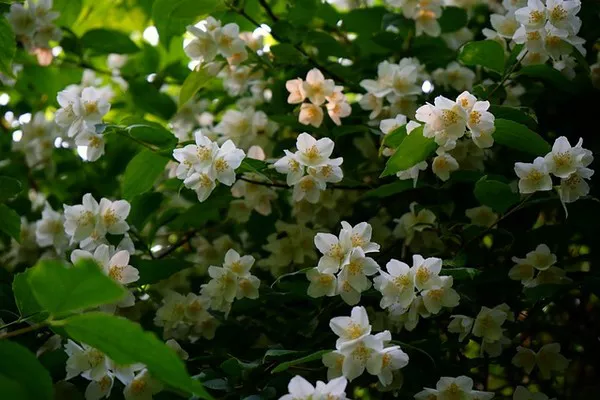Jasmine, known for its exquisite fragrance and stunning appearance, has captured the hearts of people across the world for centuries. This enchanting flower, often associated with love, purity, and grace, is a true botanical wonder. In this article, we will delve into the captivating world of jasmine flowers, unraveling their physical characteristics, unique features, and the symbolism they hold.
Jasmine Flowers: An Overview
Jasmine, scientifically known as Jasminum, is a genus of plants belonging to the Oleaceae family. This genus encompasses over 200 different species, each with its own distinct qualities and variations in appearance. However, a few common features define what a jasmine flower generally looks like:
1.Petals: Jasmine flowers typically have five or more petals arranged in a symmetrical fashion. These petals can be either white or yellow, depending on the species. In some cases, you may even find pink or red jasmine varieties, although they are less common.
2. Shape: Jasmine blossoms are often trumpet-shaped, with a narrow tube-like base that gradually widens into a flaring, star-like shape. This distinctive form contributes to their elegant and graceful appearance.
3. Size: Jasmine flowers are relatively small, with an average diameter of 1 to 2 inches (2.5 to 5 centimeters). Their petite size adds to their charm, making them a favorite for ornamental purposes.
4. Foliage: The leaves of jasmine plants are typically dark green and have an opposite arrangement along the stem. They serve as a lush backdrop to the delicate blooms, enhancing their visual appeal.
5. Fragrance: Perhaps the most renowned feature of jasmine flowers is their intoxicating fragrance. The scent is sweet, floral, and often described as exotic. It has a calming and soothing effect, which is why jasmine is a popular choice for perfumes and essential oils.
Common Varieties of Jasmine
While the basic structure of jasmine flowers remains consistent, different species and varieties of jasmine exhibit unique characteristics that set them apart. Here are some well-known types of jasmine:
Common Jasmine (Jasminum officinale): This variety, also known as true jasmine or poet’s jasmine, is famous for its sweet and intense fragrance. Its white, star-shaped flowers are the quintessential image of jasmine blossoms.
Arabian Jasmine (Jasminum sambac): Also called Sampaguita or the Philippine jasmine, Arabian jasmine features small, white, and highly fragrant flowers. It is the national flower of the Philippines and is often used in religious and ceremonial rituals.
Star Jasmine (Trachelospermum jasminoides): Despite its name, star jasmine is not a true jasmine but rather a member of the Apocynaceae family. It has glossy, dark green leaves and produces white, star-shaped flowers with a similar fragrance to true jasmine.
Confederate Jasmine (Trachelospermum jasminoides): Another imposter in the jasmine world, Confederate jasmine, boasts glossy foliage and fragrant, white, star-shaped blooms. It is a popular choice for ground cover and trellises.
Winter Jasmine (Jasminum nudiflorum): This variety is known for its bright yellow, trumpet-shaped flowers. It blooms during the winter months, adding a burst of color to gardens when most other plants are dormant.
Pink Jasmine (Jasminum polyanthum): As the name suggests, this jasmine variety produces delicate pink flowers with a sweet fragrance. It is a climber and is often used to adorn fences and arbors.
Unique Features of Jasmine Flowers
Beyond their basic characteristics, jasmine flowers exhibit several unique features that contribute to their allure:
Night-Blooming: Many jasmine species, including Arabian jasmine, are known for blooming primarily at night. This adaptation is thought to help attract nocturnal pollinators such as moths.
Evergreen Foliage: Jasmine plants often retain their dark green foliage year-round, providing a consistent backdrop for their fragrant blossoms. This evergreen quality adds to their ornamental value.
Clustering Habit: Jasmine flowers are not solitary; they typically grow in clusters, creating a stunning visual display. These clusters are especially prominent in varieties like Arabian jasmine.
Vining Habit: Several jasmine species are climbers or creepers, featuring twining stems that can be trained to grow on trellises, arbors, or fences. This vining habit enhances their versatility in landscaping.
Symbolism and Cultural Significance
Jasmine flowers hold significant cultural and symbolic importance in various parts of the world. Here are some of the most prevalent associations and meanings attributed to jasmine:
Love and Romance: Jasmine is often associated with love, sensuality, and romance. In many cultures, it symbolizes purity and eternal love, making it a popular choice for wedding ceremonies and gifts to loved ones.
Religious Significance: Jasmine has religious significance in Hinduism, where it is dedicated to various deities, including Lord Vishnu and Lord Krishna. It is often used in religious rituals and offerings.
Cultural Traditions: In the Philippines, the Arabian jasmine (Sampaguita) is the national flower and holds deep cultural and historical significance. It symbolizes simplicity, purity, and humility.
Healing Properties: Jasmine essential oil, derived from the flowers, is believed to have therapeutic properties, including stress relief, relaxation, and aphrodisiac effects. It is used in aromatherapy and massage.
Beauty and Elegance: Jasmine’s delicate appearance and enchanting fragrance make it a symbol of beauty, grace, and elegance. It is a common motif in art, literature, and poetry.
Conclusion
Jasmine flowers, with their enchanting beauty and mesmerizing fragrance, have captured the hearts of people across the globe for centuries. Their trumpet-shaped, white or yellow petals, along with their lush green foliage, create a striking visual display that has made them a favorite for ornamental and symbolic purposes alike. From their association with love and purity to their religious significance in various cultures, jasmine flowers continue to be cherished and admired.
Whether used in gardens, perfumes, or religious ceremonies, the allure of jasmine transcends boundaries, bringing joy and a touch of magic to those fortunate enough to encounter its delicate blossoms. The next time you come across a jasmine flower, take a moment to appreciate its unique beauty and the rich symbolism it carries, for it is truly a botanical treasure worth celebrating.


